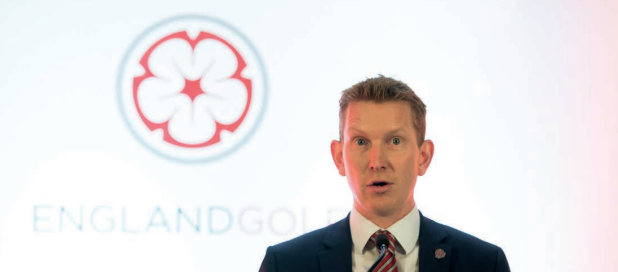England Golf chief executive Nick Pink talks to Steve Carroll about the organisation’s place in the game, the arresting Get Into Golf advertising campaign and how the body are working with club managers and the GCMA
You’ve teamed up with the European Tour to bring Golf Sixes into clubs. There has been talk of this for some time. Will this new initiative give you the impetus to do that?
Absolutely. GolfSixes has really captured the imagination of the golf world and I’m sure that our clubs and members will want to be involved.
We have got to look at alternative formats and different ways of playing the game to attract a wider audience. So why not offer Golf Sixes? Why not do something that’s fun and different?
We’ve already supported the Golf Foundation to roll out the GolfSixes league for juniors. They’ve done a terrific job and this year there are more than 125 clubs involved and more than 1,500 juniors.
Encouraging our clubs to engage with GolfSixes is a natural extension, but it isn’t just about adults. It’s giving the opportunity for dads, sons and daughters to play together, for everyone to just compete and play.
But our new relationship with the European Tour is about more than GolfSixes. We’re very keen that the professional and amateur game should be more aligned and that we have regular communication and conversations, not just about Sixes, but all things golf.
It’s great to be working with Keith Pelley (European Tour CEO). He’s brilliant and he’s really tuned in to the Gen Zs and the Millennials, and the importance of connecting to the next generation of golfer.
Do clubs need to be a little more flexible in embracing some of these initiatives? There does seem to be a disconnect in some clubs between that core and the Millennial generation, for instance…
I’m never going to say to clubs: “This is what you must do.” But I do believe that we all have to put the customer at the heart of everything we do.
That’s central to our strategy to grow the game of golf in England. It’s all about being more welcoming and understanding what customers want. It’s about providing the right service for the people coming through your door, and those you’d like to come through.
Our club support officer network is working with clubs to understand their needs, their place in the market and, from a marketing perspective, shape their offer to their customers.
I don’t think it’s difficult to get into the game but we do know there are barriers – whether real or perceived – that put people off. It’s down to all of us to break them down and simplify accessibility to the sport. That’s what we’ve done with our Get into Golf campaign: challenged the image and perception of the game.
We also need to think about how we look after people, from their first lesson to taking out membership.
That’s a huge step and we need to help the transition. I’m a great believer in looking at what other sports and leisure industries do. Take gym membership and how they get you into classes, offering taster, beginner and intermediate sessions. Obviously, they want to lock you into a membership package, but it’s tailored to you as a customer.
For too long as an industry we have been thinking about the mass. What we have to do is think about individual customers coming into our facilities and what they want. That’s today’s world. It’s consumer focused.
The focus on golf clubs has always been about full membership. It seems that this may not be what all people want anymore…
Again, this is all about being focused on the customer and providing the options they want.
When clubs are considering their membership packages I’d suggest they ask themselves: ‘What do we know about the people coming through the door? What data have we got on them?’
“We set out to spark a reaction and challenge things like dress codes and the attitudes and behaviour we have towards people”
When I started at England Golf two years ago, a remarkable number of people told me the governing body shouldn’t collect data. I believe they are wrong.
The more insight we gather, the more information we know about individuals, the better we can tailor our offer and support.
We have tools to help clubs understand their place in the market and what they can start to offer. It’s all about making sure clubs are fit and healthy, financially viable, and a focus for the community.
 Let’s talk about Get into Golf, which has been re-launched after a very successful year. It was a very striking advertising campaign. How was that conceived?
Let’s talk about Get into Golf, which has been re-launched after a very successful year. It was a very striking advertising campaign. How was that conceived?
The whole focus of the brand is aimed around openness – trying to remove the barriers we’ve been talking about and making golf accessible to everyone. It is deliberately different and it’s meant to be.
When I looked at the campaign, I thought England Golf was making a statement – about the kind of players they wanted to attract to the game and attitudes that are potential barriers to participation. Is that right?
Definitely. I’ve had some very interesting emails and letters about it, but that’s the whole point. We wanted to get a conversation going.
We set out to spark a reaction and challenge things like dress codes and the attitudes and behaviour we have towards people.
Do I expect Miss blue leather jacket, pink leather jacket and bright orange checked shirt to rock up to the club tomorrow wearing that? No, of course not.
But the point is that our models and social influencers are wearing their normal clothes. Out on the high street everyone is wearing something similar. These are people who might play golf, but when they arrive in the club car park we expect them to look and behave differently.
Why? If you watch some of our social media content, Alex, our cyclist, goes to Get into Golf sessions with a few friends. They are all wearing leisure gear, which respected the dress environment where they were. They had their session, then had a pint afterwards, doing what you and I would do.
Apart from one or two range outings they have never played golf before. Now they are experiencing it first hand and this is the market we are trying to reach.
 Is there any reason why they shouldn’t be able to come to the golf club dressed like that?
Is there any reason why they shouldn’t be able to come to the golf club dressed like that?
Not necessarily. There are clubs where you can. This is part of changing times and changing behaviours.
Some people feel it is really important there is a strong dress code in place as that naturally brings a respect of the club and environment.
Part of me understands that, but it shouldn’t be the norm. We will cut out so many people from the sport if we think that’s the norm.
The world has shifted and changed in a very short space of time and golf has to reflect that. I very rarely wear a tie for business meetings, most meetings now are smart casual. But too many golf clubs still adhere to very strict dress codes and environments that stop people from taking part.
My fear is we have a traditional core of golf club members that are ageing, and a potential new generation put off from participating because the game is caught between two stools. How do you address that issue?
Once again, it’s down to the club to decide how to appeal to different groups.
We don’t say to clubs ‘you’ve got to change’ but we do challenge, in the right way, and share information and best practice to help them make and own their decisions.
It’s important to look at issues such as: Where is the club? What’s its position in the local community and golfing market? How strong is the club?
We should talk about positive ways of attracting and retaining members and not immediately highlight the barriers.
If the first thing I am thinking when I go to a club is ‘what do I have to wear?’ – rather than ‘let’s go and have some fun’ – we’re not doing the right thing, are we?
Were you excited by the buzz that Get into Golf brought?
I’m not lying when I say I was nervous. You should be nervous about anything that’s new and different.
It’s great that we now have some 300 clubs signed up and we have thousands of activities online and people taking part.
Get into Golf is now a very focused campaign. We are targeting men and women who are 25 to 45-years-old– and we know these two groups have huge market potential for golf.
Yes, we have to cater for the 65 to 75-year-olds but we have got to start thinking about the 10, 15 and 25-year-olds coming into the sport.
It’s never been a better time to be a golf club manager in terms of CPD. With that education provided by you, GCMA, PGA, BIGGA and so on, there are huge opportunities to learn that weren’t there a decade ago…
Golf is in a strong place. I often start presentations by stating just how big the sport is.
There are at least 650,000 members of golf clubs in England. There are 2 million golfers out there playing twice a month.There are 3.6 million who play every year. With the number of facilities out there, and opportunities for golf club managers, I think it’s a fabulous industry to be involved in.
Club managers are getting younger. I’ve seen that in the GCMA statistics. Those you meet are definitely more forward thinking. They tune in really well to our resources, officers and our support packages.
There are also the training and education workshops we run and the Diploma run by the GCMA, BIGGA and PGA. Of course we can all work better together, but there are some really good people, and bodies, doing great things.
The challenge for everyone is the time issue. We’re so busy responding to enquiries and we’ve all got different agencies and partners asking for our time.
So, it’s important to withdraw at the right times.
You have to step away from the day job sometimes and put yourself in an environment with other club managers, or organisations like ours and the GCMA. That’s the way to make sure we still learn and challenge ourselves.
There is the potential that England Golf can overlap, quite a lot, in your workshops with some of the things the GCMA are doing. How do you balance that?
It’s about the customer. They decide. Organisations like ourselves and the GCMA have to manage this and tailor what we offer to support them. Our new network of club support officers is helping us to develop a much deeper understanding of clubs and their needs. But this isn’t just about England Golf, it’s about informing the golf industry as a whole and about communication.
Through this network we can be the conduit for information – whether that’s from the PGA, Golf Foundation or GCMA.
If we can be a platform for the game, we’re very happy to play that role. But we’re not taking over other areas, not by any stretch.
That might have been one of the accusations in the past – that England Golf was muscling into territories. So you see the role as one of partnership between the various bodies to try and promote the game?
We have to work in partnership. Golf has got big challenges and we have to speak with one voice.
I see our role as very supportive, facilitative and trying to make sure the right information goes to the right people at the right time.
It’s not going to happen overnight, but we have to take the partnership approach to grow the game.
You talked about the change in the demographic of golf club management. How do you feel that’s developing and what benefits is that bringing as England Golf work with clubs?
I see the benefits with our own team. Club managers are coming come to work for us as regional managers, club support officers or in national roles.
They bring experience and understanding of issues at club level which is so important.
For club managers themselves, I think it is important that they bring a different perspective to golf, together with their business acumen.
A lot of people I read about in The Golf Club Manager, and speak to at clubs, haven’t got golf industry backgrounds.
I came from cricket. I’ve been asked: ‘what do you know about golf when you’ve only been working in the industry for two years?’ Well, I’ve played golf all my life. I’ve been a customer and consumer all my life.
What we are seeing with the younger demographic of club managers is people who are perhaps more open minded, see the issues and want to overcome them.
It’s a unique industry in that you’ve got proprietary clubs run as business operations and private members’ clubs that may be run by volunteers with its well being at heart. That creates interesting situations…
It does. From a governing perspective, we have to tailor our support appropriately.
We have to put the right questions to private members’ clubs and to proprietary clubs, to make sure the support we offer is valid on both fronts.
A total of 45 per cent of clubs in England are proprietary. It’s a very important area and over the last two years we have built very strong relations with this sector.
Richard Flint and Abbie Lench, on our club support side, have done a really good job getting closer to some of the bigger operators such as the Burhill Group and Crown Golf. Their business model is very different to a private members’ club.
What we see on the private members’ side is demand for a lot more support with business planning, development and governance. As a result, a number of these clubs are starting to take strides in areas such as looking at incorporation and making sure the responsibilities at committee level are the right ones.
You mentioned the club support network. How can those people help clubs and club managers do their jobs better?
What we wanted to do was focus specifically on the club, find out about their needs and how we can support them.
Our network provides a point of contact for every club in the country. Clubs can visit our website and see who their officer is, or they can get in touch with us at headquarters and we can put them directly in touch.
I was really keen to push this out. I felt we weren’t close enough as an industry, let alone England Golf, to the needs of clubs. I want officers almost eyeballing managers, volunteers and committees on a much more regular basis than we were able to do previously.
We’ve had a great take up. In the last 12 months, we’ve visited 1,200 clubs and made a total of 4,500 visits, which is a staggering number.
We know how many meetings were light touch, and how many lasted well over an hour. We know what the visits were about. Using our new CRM system, officers are able to upload action plans immediately following the meeting.
I’ve got a dashboard I can look at on a monthly basis telling me where the issues are, and where we need to invest to develop further support and resources to clubs.
A tracker that Sports Marketing Surveys have helped set up provides feedback from clubs.
So far 679 of 1,200 clubs have fed back independently. They have assessed how good the visit was, the length of the visit, what it was about and then provided some qualitative information.
We have got lots of good data and, for the club manager, we can pool and service that information to make sure we are providing the right training and education.
Will you be able to share that information with organisations like the GCMA?
We do. That’s exactly the point of doing it. It’s to grow the wealth and understanding of the industry.
Is it difficult when there’s all this good work going on in the background and you see some of the negative stories in the news and on social media? How much damage does it do?
It’s damaging, without a doubt. Golf can be an easy target because people have a certain view and image of the sport.
Those of us in golf defend it and say ‘no, it’s not like that at all. Come on down and you will experience something different’.
But we are also quite aware of some of the issues in our own clubs and our own environments where we play and enjoy the sport.
We’ve got to get on the front foot. We’ve got to talk about the positive things in the game.
It’s not just about England Golf or GCMA through the magazine. It’s all of us. We’ve all got to be shouting about it.
The most important thing is the message. Do people really connect with Nick Pink, chief executive of England Golf? I hope not.
I hope the most important thing they see is the new partnership with the European Tour on Golf Sixes, showing that golf is fun, friendly – or whatever the story might be. That’s the most important thing we’ve got to get out there.
How optimistic are you about the future of the sport at the moment?
I am upbeat and always have been. I love the sport. It’s in my core. I am really encouraged by what I am seeing out there.
There are great people and fantastic managers that I have met, who are doing some brilliant things and some great work.
They’re taking away the barriers and when I walk into those clubhouses, I feel the difference. When my board challenges me, it’s difficult to measure ‘feel.’ But it’s definitely a different experience.
We’ll soon be giving the results of our two-yearly Golf Club Questionnaire and the headline will be all about the importance of being welcoming.
This is simple customer service, which we sometimes lose sight of because we are so focused on this programme or that initiative. Everything comes down to people. How you interact with them, what questions you ask, how you meet them at the front door.
I’ve had some really great experiences and I can’t think of one organisation that hasn’t got the game at its heart. That’s really important.
So I am really optimistic and positive about golf. Pictures courtesy of Leaderboard Photography
Who is Nick Pink?
Nick was the European manager for the International Cricket Council (ICC) before taking up the post as chief executive of England Golf in March 2016. He’d been responsible for a 35 per cent increase in cricket participation across the continent in his time in the role, so it was no surprise England Golf turned to him to shore up numbers in the sport. He had previously also worked at a number of leading sports organisations, including UK Sport, the Youth Sport Trust and the Commonwealth Secretariat. In his time in the England Golf hotseat, he has led a number of initiatives to drive up the numbers playing the game, most recently entering into a partnership with the European Tour to take Golf Sixes into clubs around the country.



